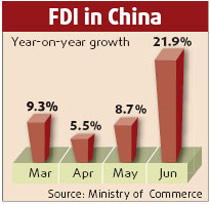China has underscored its intention to open up the country's financial markets by tripling the investment quota of qualified foreign institutional investors (QFII) from 10 billion U.S. dollars to 30 billion U.S. dollars.
The announcement from the State Administration of Foreign Exchange (SAFE) came ahead of the 18th U.S.-China Joint Commission on Commerce and Trade and the third Sino-U.S. Strategic Economic Dialogue, which are to open on Tuesday and Wednesday, respectively.
This expansion was the second enlargement of the QFII program, launched in 2002 with a quota ceiling of 4 billion U.S. dollars on a trial basis.
The previous expansion, in 2005, was 6 billion U.S. dollars. However, no foreign institutional investors have acquired any new quotas since February, when the then 10-billion-dollar quota was running low.
Shang Fulin, chairman of the China Securities Regulatory Commission, told reporters in October that raising the QFII quota was a common understanding reached at the second Sino-US Strategic Economic Dialogue.
The SAFE said it would "decide the tempo" of quota issues in line with China's international payments and the development of the domestic stock market.
"Eligible overseas medium- and long-term investment will be encouraged to invest in China's capital market," it said.
Reviewing the performance of QFII funds over the past five years, the SAFE said that the system had facilitated a transformation in Chinese investors' sophistication, improved risk management, strengthened the global clout of Chinese capital markets and helped optimize corporate governance.
The QFIIs, described by the SAFE as "significant institutional investors", numbered 49. Their aggregate market capitalization was nearly 200 billion yuan (about 27.02 billion U.S. dollars).
Industry analysts said the government had previously been reluctant to raise the QFII quota, both for fear of sparking currency appreciation and concern that the domestic stock markets were near bubble territory.
Separately from the SAFE announcement, Liu Mingkang, chairman of the China Banking Regulatory Commission, played down fears of overheating in comments made at an annual conference sponsored by Caijing Magazine in Beijing Monday.
"The benchmark Shanghai index has more than tripled from 2003 to this November, which is still small compared with other BRIC [Brazil, Russia, India, China] nations. Russian stocks rose nearly 631 percent, Brazilian stocks, 576 percent and Indian stocks, 596 percent," he said.
To promote steady development of the financial markets, the SAFE also said that it would expand channels for local residents to invest abroad and raise the investment quota for qualified domestic institutional investors (QDII).
"We support more eligible local financial institutions being able to provide more diversified products for domestic investors, enhance their risk management and establish new advantages in global competition," said the SAFE in a statement.
As of end-September, all QDIIs -- including banks, funds, insurers and securities dealers -- had acquired investment quotas of 42.17 billion U.S. dollars, with an actual outflow of 10.86 billion U.S. dollars.
The benchmark yuan-U.S. dollar exchange rate hit a new high of 7.3872 on Nov. 27, for a cumulative appreciation of nearly 11 percent since China discontinued the peg to the greenback in July 2005.
China's central bank governor, Zhou Xiaochuan, said on Nov. 18 that if necessary, the nation would consider widening the yuan's trading band.
(Xinhua News Agency December 10, 2007)


